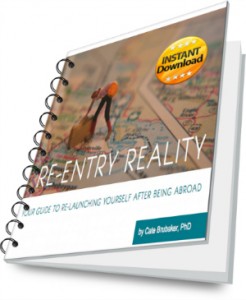Re-Entry Reality: Personal Growth or Cultural Over-adaptation?
It’s Re-Entry Reality Monday! Would you like to share your Re-Entry Reality? Contact me – I’d love to talk with you!
……………………………………………………………………………………………………..

Brendan Yorke is a research analyst who aims to improve K-12 student achievement, especially multicultural integration.
While previous cross-cultural experiences affected how I look at the world, the challenges of re-entry were most closely felt as I traveled back and forth from the University of North Carolina at Chapel Hill and my home in rural Nova Scotia. While Canadian and American cultures share many similarities, the subtle differences in social dynamics created significant hurdles.
Creating relationships in a new culture felt like riding a bike for the first time. The handlebars swung from side to side as I overreacted to the expected (and assumed) potholes. Over my time in the US, I began to feel more and more comfortable with how I interacted with Americans. Some of this was in conscious lessons, like focusing on similarities, while others were adjustments I didn’t recognize at first, like smiling more.
Travelling home helped me better recognize the changes in myself. My cousin was the first person to angrily tell me that I had become over-confident, superficial, and competitive – aka the stereotype trifecta of the US. I was shocked. Her interpretation reminded me how I had understood Southerners as a first-year student.
Because the interpretations of those close to me impact how I see myself, getting this feedback was like going through the cultural transition all over again. The biggest hurdle in the return journey was dealing with the fact that my personality had indeed changed. However it was difficult to determine which aspects of this change were personal growth and cultural over-adaptation.
I wish that I had known that there are differences between personality and cultural expression. In other words, by understanding how American and Canadian “terrain” tended to differ, I could learn to adapt myself to interactions in both cultures. And finally I wish that I had known that cultural adaptation did not mean that I was superficial, but rather that I could communicate my personality more accurately.
In the process of understanding these differences, I benefited from studying cultural transition from academic and service perspectives. I studied US American peer relations in a psychology lab, wherein I learned which middle-school students had the most influence on their peers behavior. Indeed the most popular were confident, aggressive youth with many acquaintances.
I also had the opportunity to tutor young people from immigrant backgrounds studying English as a second language. Seeing their struggles to win over their American peers, helped me see points of similarity in their sense of humor or other parts of their personality.
Overall, studying cultural differences in these ways helped me sift through my host and home cultures traits to distinguish true cultural differences from over-generalization. After understanding the real points of connection among these two cultures, I learned to better interpret and express myself in the rural Nova Scotian and North Carolinian milieux.
If re-entry were a food it would be Grammy’s Apple Pie. My grandmother makes a pie that no one can manage to duplicate, even with the recipe. She bakes it by feel and you need to watch her closely to get the technique right.
We think re-entry should be easy—we’ve grown up in this place, we know the recipe. But, before you can make the transition back, you have to loosen your grip on the old recipe and start observing home anew.
Thanks, Brendan!
The Re-Entry Reality: Your Guide to Re-Launching Yourself After Being Abroad workbook and support is available! Half of each workbook purchase goes to help a high school student study abroad. Click here to check it out.
[/callout2]


